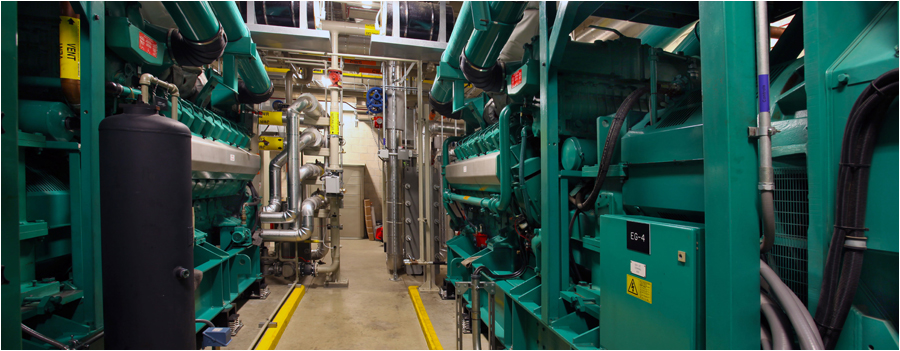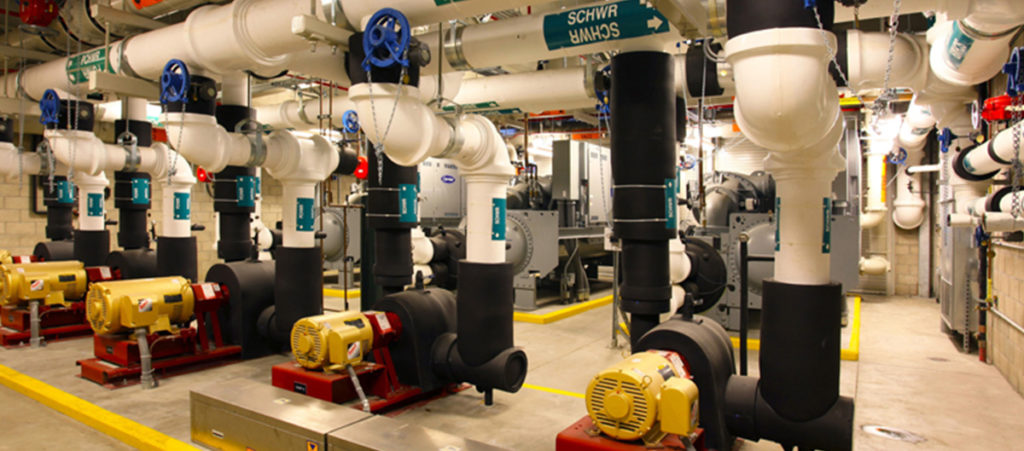West Coast Air Conditioning Co. Inc.
Celebrating 50 years in 2012
1155 Pioneer Way, suite 101
El Cajon, CA 92020
619-561-8000
Some sparks you want.
Others you don’t.
Adversarial relationships are all too typical in the construction industry, but they don’t serve your best interests.
We do. As an owner’s contractor, West Coast Air Conditioning Co. will be at your side from your project’s inception through completion. We’ll serve as your advocate. We’ll tell you exactly what needs to happen for you to get what you want, and then we’ll do what it takes to make it happen.
The only sparks you’ll get from us are the ones you want.
Specialists in:
Cogeneration /power creation
Central plants
School construction and modernization
Energy reduction
Central Utility Plant
State –of-the-art facility delivers reliability and cost-savings
The nearly nine million passengers who traverse the Thomas F. Riley Terminal at John Wayne Airport each year will no doubt notice and appreciate the new facilities’ many amenities, from the wide variety of concessions and more efficient passenger and baggage screening, to the improved parking access and even the four new art displays.
Less noticeable to travelers- but no less significant an improvement- is the new, $30.5 million Central Utility Plant. Completed as a design-build project by West Coast Air Conditioning Co., this innovative facility supplies electrical power and chilled water to serve the air conditioning system for the entire airport 24/7/365.
Immunity to blackouts
The new plant replaces an approximately 40-year-old, outdated facility. One of its most important features is that this cogeneration plant gives its owner, the County of Orange, the security of a consistently reliable source of power, making John Wayne Airport a sustainable facility that is virtually independent from Southern California Edison.
“Our cogeneration clients choose this path to obtain significant cost-savings,” says West Coast Air President, David Dudley, “but for the majority of them who own facilities where even a momentary interruption in power service3 can’t be tolerated, reliability is the crucial factor.”
At the airport’s new plant, four natural-gas-fired engines run generators to produce 7.8 megawatt-hours of electricity- enough to power 6,000 average homes- allowing the airport to be mostly independent from Southern California Edison and thus stay online during blackout.
“This reliability is an enormous plus,” Dudley notes. “The plant has been operating since late last year and has proven itself several times already during power outages.”

Sustainable features
Power generation is just one of the Central Utility Plant’s purposes. The other is the capture and reuse of the 950-degree exhaust heat emitted by the engines that drive the generators. This heat is used to create 240-degree water which in turn is used to drive two 535-ton absorption chillers that provide what is, essentially, free chilled water used to air condition the airport’s various buildings.
With more than 725,000 square feet of space in airport buildings to air condition, three 750-ton centrifugal chillers powered by electricity generated at the plant are put into service to produce chilled water alongside the two absorption chillers.
Cost-savings
Now that it’s operational, the Central Utility plant is expected to save the County roughly $2 million per year in electricity costs. In fact, Dudley notes, the cogeneration portion of the plant is expected to pay for itself in approximately ten years and to serve the airport’s needs for another two decades or more after that.
Cost-savings began accruing long before the plant became operational, however. By electing to make this a design-build project rather than a traditional design-bid-build project, the County set the stage for the project to be completed more quickly. West Coast Air was able to begin construction of the foundations and walls of the 11,000-square-foot building that houses the plant’s equipment while the mechanical and electrical systems were still in design, thus compressing the schedule.
Several significant cost-savings were realized long before construction began. During the project’s six-month design phase, West Coast Air personnel brought their specialized expertise to bear, providing ideas that would result in the plant’s paying for itself more quickly. Through value engineering, the team was able to enhance the amount of heat to reclaim off exhaust- so-called free heat – and provided an additional 150 tons of free chilled water by this heat-reclamation process.
During its constructability reviews of the project’s design, West Coast Air focused on how to build the new plant while allowing the entire airport to remain operational throughout the 14 month construction schedule. Originally the County had contemplated a separate switching station; however, thanks to West Coast Air’s input, this element was deleted from the scope for a seamless transition from the old central plant to the new – and for a savings of nearly $500,000 thanks to the elimination of unnecessary work.
“From the project’s inception, West Coast Air’s management team explained to us exactly what needed to happen in order for us to get what we wanted,” says John Wayne Airport Project Manager Rick Cathey. “In many instances, they interpreted what we wanted before we even knew what it was.
“When construction was underway, we stepped aside and trusted them to do what it took to make it all happen. That’s why I call them the get-out-of-the-way contractor,” he jokes.
Cogeneration experts
In response to the 2001 rolling blackouts throughout California, the County of Orange instituted a program to upgrade the central plant functions of the Santa Ana Civic Center to reduce dependence on the local utility power grid. The County tapped West Coast Air for the project, and in 2009 the company completed the construction of a $30 million, 10.4-megaswatt cogeneration plant that serves 16 County buildings in the heart of downtown Santa Ana. West Coast Air highly successful performance on that project, which was brought in on time and under budget, was repeated with the airport project. As Dudley remarks, “We are proud to count the County of Orange as a repeat client for cogeneration facilities.”
In fact, West Coast Air is a dominant leader in the construction of these types of facilities. Founded by David Dudley’s father, Fred Dudley, in 1962, the company built its first cogeneration plant in 1978. In its nearly 50-year history – the company will celebrate that milestone anniversary next year – West Coast Air has constructed more than 100 central and cogeneration plants.
Specialized expertise
As the prime design-build contractor for the airport’s central plant, West Coast Air enlisted Syska Hennessy Group as its design consultant. In so doing, it reunited the team that designed and constructed the County of Orange’s earlier cogeneration project.
What’s more, all six men on West Coast Air’s Central Utility Plant project management team worked together on the earlier project as well – and, Dudley is proud to point out, they have a combined total of 172 years of construction-industry experience. He also notes that every project that West Coast Air takes on is managed by a corporate officer: He served as project executive for both Orange County projects, with company Vice President John Krueger as project manager.
For the airport project, West Coast Air subcontracted the electrical work to Baker Electric, a company with which the general contractor has teamed many times on cogeneration and central plant projects. Baker’s work includes running 175,000 lineal feet – 33 miles – of electrical wiring from the plant to various locations throughout the airport.
Other key players were Cummins Power Generation, for provision of the heat reclamation and emission systems, Parsons Transportation Group for program management and Barnhart Balfour Beatty for construction management.
Deceptive name
“Don’t be fooled by our company’s name,” Dudley comments. He’s referring to the fact that West Coast Air is a general contractor, not solely a builder of mechanical and electrical systems, and that the company build entire school campuses from the ground up. With an average of 120 employees working in eight trades, West Coast Air employs as many as 170 workers in the summer months, when school construction peaks. Currently, the general contractor is in the middle of a $150 million renovation and upgrade of nine schools in the Los Alamitos Unified School District, among other school projects.
The company’s third area of specialty is in energy reduction for schools, military facilities, cities and counties. This work entails the replacement of air-conditioning and lighting systems, the provision of thermal and photovoltaic solar systems, and the use of alternative power-generation systems.
Dudley brushes off the suggestions that West Coast Air should consider changing its name, saying, ”We do just fine the way we are.” That’s a bit of and understatement, however. The company remains busy through both good and bad times in the construction industry, Dudley notes, and its network of clients – who have confidence in West Coast Air’s ability and insistence upon perfection – allow the general contractor to thrive while others in the industry fail.
What’s more, nearly 90 percent of West Coast Air’s business comes from repeat clients who appreciate that company is what Dudley calls “an owner’s contractor.” By this he means that, in an industry too often characterized by adversarial relationships, West Coast Air consistently strives to provide the ultimate system an owner can have, on or ahead of schedule and often under budget.
“We focus on developing creative solutions, on working in a collaborative spirit with every owner, and on adding value to every project we construct,” Dudley says.
It’s a formula for success. “I would have them back in a heartbeat,” JWA’s Cathey says.

